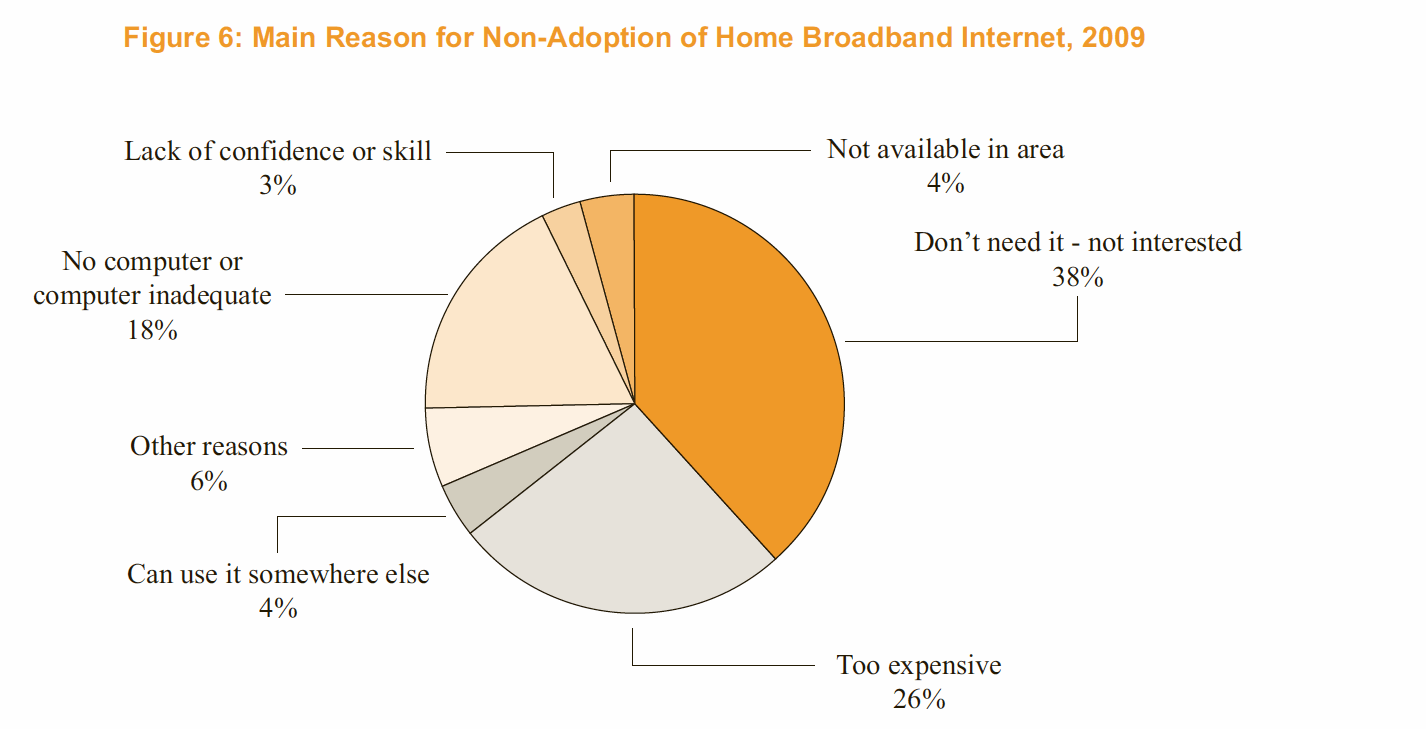U.S. DEPARTMENT OF COMMERCE: ECONOMICS AND STATISTICS ADMINISTRATION & NATIONAL TELECOMMUNICATIONS AND INFORMATION ADMINISTRATION
EXECUTIVE SUMMARY
Household use of broadband Internet service has risen dramatically during the first decade of the 21st century as the Internet has become integral to the lives of most Americans. Nonetheless, not everyone uses broadband Internet – either by choice or because they lack access. This report, prepared jointly by the Commerce Department’s Economics and Statistics Administration (ESA) and National Telecommunications and Information Administration (NTIA), explores differences in broadband Internet use among households.
Earlier studies by NTIA and others have shown that broadband Internet use varies significantly across households of different socio-economic backgrounds and in different geographic locations. This report builds on the findings of an NTIA report published earlier in 2010 showing that while broadband Internet access rose between 2007 and 2009 for most demographic groups and geographic areas, persistent differences in levels and growth rates remained (NTIA, 2010). That report found highest rates of home broadband Internet use among Asians and Whites, married couples, younger people, urban residents, people with higher incomes, and people with more education. This report expands the analysis presented in the earlier NTIA report to examine these differences in broadband Internet use in greater detail.
This report and the earlier NTIA report used data from a special 2009 supplement to the Census Bureau’s Current Population Survey (CPS), which asked questions about broadband Internet use of more than 50,000 households.
The principal findings of this report are as follows:
General Broadband Internet Access
- Seven out of ten American households used the Internet in 2009. The majority of these households used broadband services to access the Internet at home. Almost one-fourth of all households, however, did not have an Internet user. (Section 3, Figure 1)
Determinants of Household Adoption of Broadband Internet
- Income and education are strongly associated with broadband Internet use at home but are not the sole determinants. (Section 4.1, Table 1; Section 4.2, Table 6)
- Broadband Internet adoption was higher among White households than among Black and Hispanic households in 2009. Differences in socio-economic attributes do not explain the entire gap in broadband Internet adoption associated with race and ethnicity. (Section 4.2, Figure 2)
- A similar pattern holds for urban and rural locations. Urban residents were more likely than their rural counterparts to adopt broadband Internet, even after accounting for socio-economic differences. (Section 4.2, Figures 3 and 4)
- Home broadband Internet use by people with disabilities lagged adoption by those with no disability. Differences in socio-economic and geographic characteristics explain a substantial portion of the adoption gap associated with disability. (Section 4.2, Figure 5)
Main Reasons for Non-Adoption of Home Broadband Internet
- Lack of need or interest, lack of affordability, lack of an adequate computer, and lack of availability were all stated as the main reason for not having home broadband Internet access. The significance of these factors, however, varied across non-users, with affordability and demand generally dominating. (Section 5, Figure 6)
- Internet non-users reported lack of need or interest as their primary reason for not having home broadband Internet access (Section 5.1, Figure 7). This group accounted for two-thirds of nonusers of home broadband Internet.
- In contrast, households that did not use the Internet specifically at home but reported using the Internet elsewhere ranked affordability as the primary deterrent to home broadband Internet use (Section 5.2, Figure 8). This group represented almost one-fourth of non-users of broadband at home.
- Affordability was also reported as the major impediment to adopting broadband Internet services in households that used dial-up services (Section 5.3, Figure 9). This group represented about one-eighth of non-users of home broadband Internet services. Lack of broadband availability was reported to be a significant factor for rural residents (Section 5.3, Table 13).
- The use of dial-up Internet service is shrinking among households that connect to the Internet from home. Dial-up users, on average, were older, had lower levels of family income and education, and were more likely to reside in rural areas. (Section 6, Tables 16 and 17)
Long-term Trends in Broadband Internet Use
- Between 2001 and 2009, broadband Internet use among households rose sevenfold, from 9% to 64% of American households utilizing broadband Internet. (Section 8.1, Table 23)
- Some of the demographic groups that had lower-than-average adoption rates in 2001 have since exhibited impressive gains. However, sizeable adoption gaps still remain in broadband Internet access among demographic groups defined by income, education, race, and ethnicity. (Section 8.1, Table 23)
- Geographic areas such as states, as well as urban and rural locations, have experienced significant growth in home broadband Internet use between 2001 and 2009. Significant gaps in adoption still persist among the states, some regions, and between urban and rural locations. (Section 8.2, Table 24; Section 8.3, Table 25)
Download full report (PDF): Exploring the Digital Nation
About the U.S. Department of Commerce
www.commerce.gov
“The U.S. Department of Commerce has a broad mandate to advance economic growth and jobs and opportunities for the American people. It has cross cutting responsibilities in the areas of trade, technology, entrepreneurship, economic development, environmental stewardship and statistical research and analysis.”
Tags: Economics and Statistics Administration, ESA, National Telecommunications and Information Administration, NTIA, U.S. Department of Commerce







 RSS Feed
RSS Feed